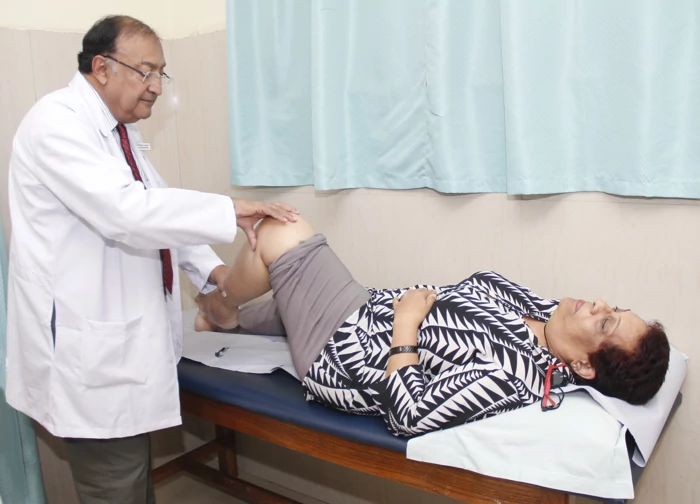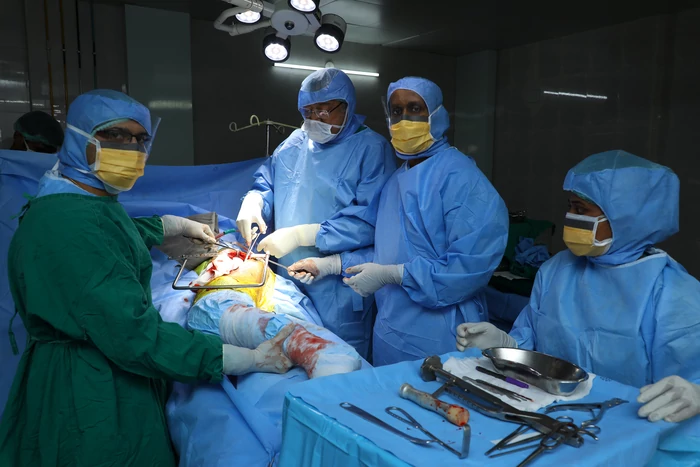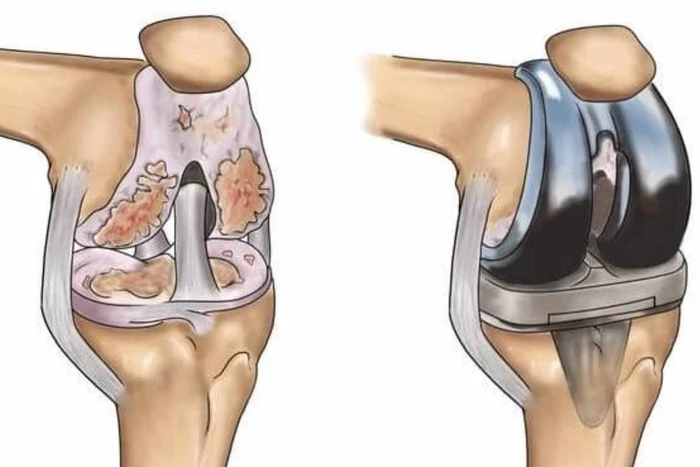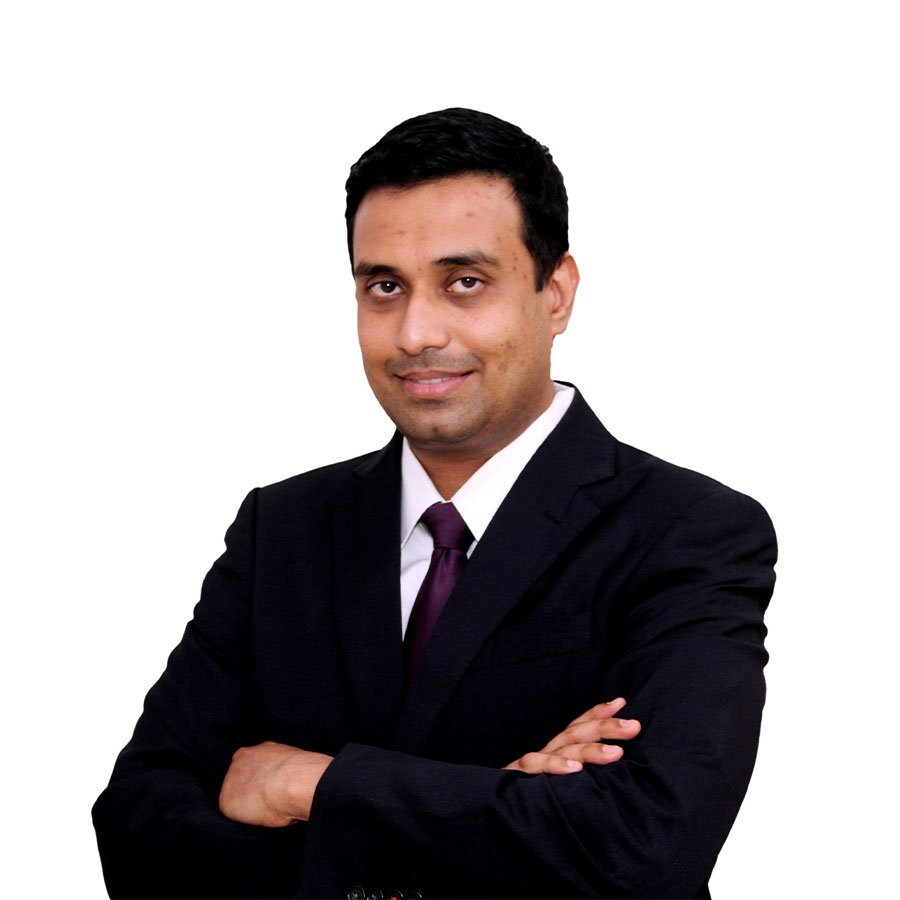WHY REPLACE YOUR KNEE?
The most common reason to replace a knee is arthritis resulting in pain, stiffness, deformity or instability which interferes with your lifestyle and is not controlled with simpler measures, such as medication, using a cane, or less extensive surgery such as arthroscopy. A normal knee joint has smooth cartilage surfaces which glide across one another with almost no friction. In an arthritic knee, the joint surfaces are rough and irregular, causing pain as the uneven surfaces grind across each other. In a knee replacement operation, the rough surfaces are replaced with smooth, gliding components and the deformities and stiffness are corrected.

HOW IS SURGERY PERFORMED?
Most commonly, the surgeon enters the knee through an incision centered over the front of the joint. The capsule of the knee is opened generally on the inside edge of the kneecap. The muscles and tendons are then pulled out of the way and the knee is bent to expose the arthritic bone ends. Two to three millimeters of bone are removed from the ends of both the tibia and the femur, which are shaped to accept the implants. The metal implants are anchored to the tibia and femur, using bone cement or a press fit technique. The technique of fixation depends on many factors, such as the strength and quality of your bone. A plastic implant is attached to the tibial implant to form a firm, stable, low friction articulation between metal and plastic. It is common to find considerable damage to the joint surface of the kneecap requiring it to be resurfaced as well. At surgery, great care is taken to restore the overall alignment of the knee and the position and function of the kneecap.

Gradual deterioration of cartilage that occurs in osteoarthritis is the most common reason for hip replacement surgery. Implanting an artificial joint eliminates pain and restores near-normal movement. It is done for patients suffering from arthritis. Hip replacement implant has the same parts as your own hip-a smooth ball of special metal is inserted with a stem with the bone canal, a cup of special plastic replaces the wore-out socket. Most commonly the implants are cemented (like a special glue in young patients, sometimes non-cemented implants are being tried but no definite proof that non-cemented is superior. Patient starts walking on the second day with walker, then with stick, putting weight on the ground. Rest of the program is as in the knee.
HOSMAT Joint Replacement Center is headed by Dr. Thomas A Chandy – Chief of Orthopedics and Joint Replacement Center who has had a rich experience expanding over 18 years in the U.S. He has successfully done 1700 Joint Replacement surgeries to date, 1000 in the U.S. and 500 at HOSMAT Joint Replacement Center at an average rate of 150 – 200 per year. HOSMAT Joint Replacement Center has been recognized by Johnson & Johnson for a Fellowship program, with one Fellow every 6 months. HOSMAT Joint Replacement Center has all the facilities which are mandatory for Joint Replacement surgeries to be undertaken. It is supported by excellent physiotherapy and occupational therapy staff.
Dr. Thomas A Chandy is a US Board certified Orthopedic specialist who returned to Bangalore in 1993, after 20yrs in the US with vast experience in Joint Replacement & Orthopedic Surgery.
HOSMAT ARTHRITIS & JOINT REPLACEMENT CENTRE
HOSMAT joint Replacement centre is headed by Dr. Thomas Chandy –chief of Orthopedics and joint replacement centre who has had a rich experience of over 25 years of which 18 years was in the United States. He has successfully done about 8000 joint replacement in the US and at HOSMAT an average rate of 600 replacements each year till date. Dr. Thomas Chandy is a board certified US specialist who returned to Bangalore after 18 years with a vast experience in joint replacement and orthopedic surgery. After completing a five year post graduation resident training in 1980 in orthopedics at Jewish Hospital and medical centre in New York, he was on the faculty at the same hospital for two years.

Dr. Chandy trained at the University of Oklahoma for two fellowships in joint replacement, arthroscopy, sports medicine and knee surgery. He was appointed as chief of orthopedics at the Claremore regional Medical centre in 1983. At this time the idea evolved to start a world class orthopedic, joint replacement, neuro and accident hospital of an international standard. Dr. Chandy is one of the first U.S Board certified orthopedic surgeons in India.
The department undertakes a comprehensive evaluation of each patient which includes pre- Op evaluation and post Op Rehabilitation, led by a team of Rheumatologists, highly skilled Orthopedic surgeons and joint replacement surgeons who have been trained extensively in their respective fields—- shoulder – wrist- Hip- knee-ankle joints respectively. The joint replacement centre has both medical and surgical management for joint pain. Chronic pain—Non Surgical approach gives a temporary relief, Surgery is the choice of treatment for advanced stages of arthritis. HOSMAT joint Replacement Centre has dedicated operation theatre with vertical laminar flow – (Ensures germ free atmosphere). Exclusive joint Replacement Surgeons supported with advanced cutting edge technology for challenging cases. Dedicated team of anesthetists that provide Pre – Op, Intra-operative and postoperative care.. Lowest infection rate in the country which is less than about 0.5% . Average infection in the U.S Hospitals is 1-2% and average infection rate in Indian hospitals in general is over 5 %. Computer Navigation system with high definition cameras and arthroscopies State-Of-the Art Bone Bank for revision arthroplasty and situations where there is Bone Loss and requires grafting.


